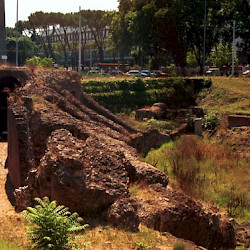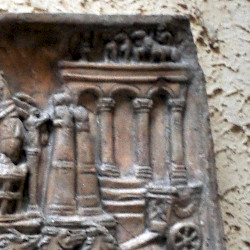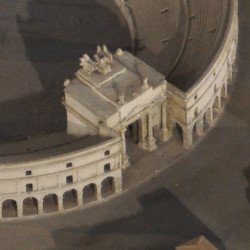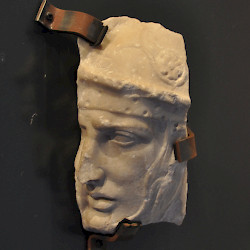Rome, Circus Maximus, Triumphal Arch of Titus
Q2017708Triumphal Arch of Titus: the arch in the Circus Maximus in Rome that was erected to celebrate Titus' capture of Jerusalem. It is not the same as the more famous Honorific Arch of Titus on the Velia, overseeing the Roman Forum.
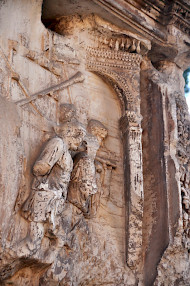
The central arch in the curve of the Circus Maximus was the triumphal arch of Titus, the general who, under orders from his father, the emperor Vespasian, had taken the city of Jerusalem and burned the Jewish temple. From reproductions on ancient reliefs, we know that it had three arches; there was a quadriga on top of it.
The triumphal arch in the Circus Maximus stood at the place where in 64 CE the fire that destroyed a large part of Rome had broken out.note The emperor Nero had blamed the Jewish sect of the Christians for the conflagration, and it seems that the memorial was erected here as a warning to the residents of the neighboring Jewish-Christian district: we've not forgotten that some of you once set fire to Rome.
Titus’ triumphal entry took place in 71, but the permanent monument in the Circus Maximus was not complete until the year 81, when he himself was emperor. We can deduce this from the honorary titles which are mentioned in the inscription:note
Senatus
populusq(ue) Romanus
Imp(eratori) Tito Caesari divi Vespasiani f(ilio) Vespasian[o] Augusto
pontif(ici) max(imo) trib(unicia) pot(estate) X imp(eratori) XVII [c]o(n)s(uli) VIII p(atri) p(atriae) principi suo
quod praeceptis patriae consiliisq(ue) et auspiciis gentem
Iudaeorum domuit et urbem Hierusolymam omnibus ante se ducibus
regibus gentibus aut frustra petitam aut
omnino intemptatam delevitThe Senate and People of Rome to their princeps, Imperator Titus Caesar Vespasianus Augustus, son of the divine Vespasian, pontifex maximus, in the tenth year of his term as tribune, proclaimed imperator seventeen times, consul eight times, father of the country, because, at the behest of his father, with his advice and under his auspices, he did subjugate the Jewish people and lay waste to the city of Jerusalem, which all leaders, kings and nations before him had either failed to do or had left untried.
To be sure, nothing remains of this triumphal arch today – a medieval turret stands more or less on the same spot – but an eighth century pilgrim from Einsiedeln, who had visited Rome, included a copy of this inscription in his account of his journeys.
